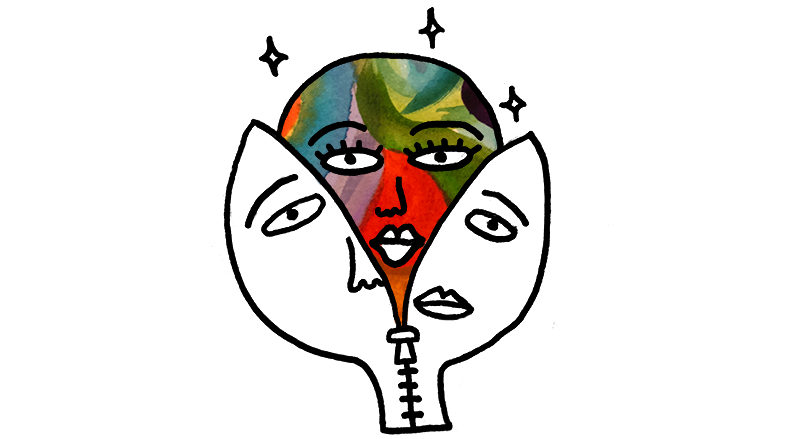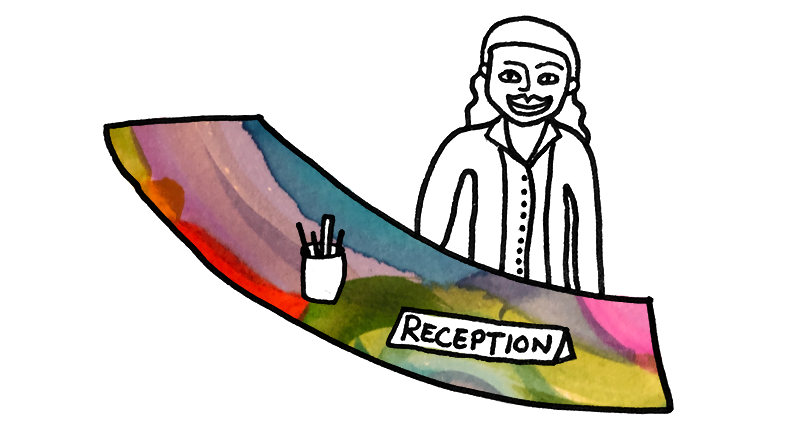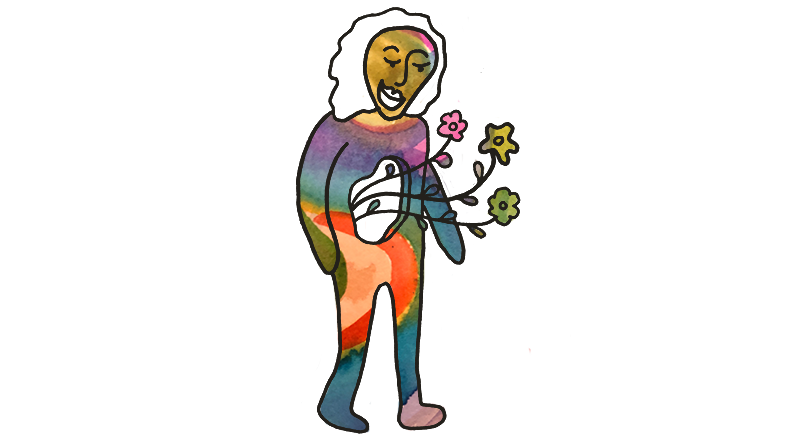In the movies, makeovers are the answer to everything. Before, she is identifiable only by her big, bulky glasses and untamable, frizzy hair. She has no fashion sense, no boy sense, no social sense. No one notices her, no one pays attention. No one cares.
Then, something happens. It doesn’t really matter what or how — someone notices her, she becomes a princess, or a part of a bet — it just matters that now, things are different. Now, she must change. So, with the help of a friend or a makeup team, she goes from ugly and unknown to pretty and popular. Someone forces a flat iron to her hair, foundation to her face, heels on her feet. In an hour and a half, two tops, the grand transformation has occurred.
Suddenly, she’s wanted. The mean girls want to be her friend and the popular boy asks her to the dance. She stands taller, speaks louder, sounds smarter, her clear skin and cleavage making her more confident.
These transformations are not hard to come by. They’re ever-present in films like She’s All That, The Princess Diaries, and Grease. It’s about working out and working hard, in search of a bigger, better version of yourself. Eating what you want, but still staying slim. Watching Netflix for hours on end, but still going to the gym.
The makeover is something out of every girl’s fantasy — mine included — but I didn’t always used to see it that way. The first time I saw Grease, at around seven or eight years old, I hated it. I couldn’t believe that Sandy started smoking and dressing differently, just so she could be with Danny. She changed for him, exchanging her long skirts for leather pants and headbands for hoops. I liked the old Sandy. She was sure of herself before, protesting against Danny’s indifference and unsolicited advances. She used to be her own person. Now, she was unrecognizable.
No one else seemed to agree with me, though. Everyone else seemed to like the movie. Sexy Sandy was a popular Halloween costume. Grease was a popular high school musical. It was even on Broadway. Maybe this was just the way things were. Maybe the only way to transform your life was to transform yourself.
The more time that went by, the less I disliked Sandy and the more I wanted to be like her — brave, outspoken, courageous. In control of something, even if it was just my love life. But I wasn’t like any of the girls in the makeover movies, at least not in the ways I wanted to be. Sure, I was smart and had bad vision and didn’t know how to talk to boys, but that was always the Before. And no matter how much I wished for or wanted it, there were no fairy godmothers or concerned classmates coming to help me. There was no clear path to my Happily Ever After. No clear example or role model for me to follow.
In the NBC sitcom, The Office, life — and makeovers — are not as grand or as obvious as we tend to think they should be. The Office, which was filmed as a mockumentary, ran from 2005-2013. It followed the everyday lives of the employees of Dunder Mifflin, a paper company in Scranton, Pennsylvania, where the most exciting things to happen were cocktails at Chili’s and the cake picked by the Party Planning Committee.
The Office makes the absurdity of your overbearing boss and banal job not only bearable, but laughable. It turns sad Secret Santa gifts and annoying desk mates into comedy, showing us the humor in the banality, the friendships that form in the boredom.
Most of us are average. Our lives are ordinary. Normalcy is familiar to us — we know how it looks, tastes, and feels. A cubicle, a dead-end job. Selling insurance, checking accounts, or paper. The same coffee, same cereal, same sandwich for lunch every day.
When we meet Pam, the office’s receptionist, there is nothing special about her. She’s doing something she clearly doesn’t want to be doing in a place she clearly doesn’t want to be. She wears awkward, over-the-knee skirts and atrocious, pastel cardigans. She clearly doesn’t know how to handle her curly hair. She talks about wanting to be an artist, but never does anything about it. She even turns down an offer from corporate to participate in a training program for graphic design. She talks about her dreams of a house with a terrace, but knows she will never do anything to get it. To her, “dreams are just that. They’re dreams. They help you get through the day.” Her life is lifeless. She is listless. Static. Still.
Eventually, though, Pam is forced to make a choice. She can either stay with Roy, her stale and lifeless high school boyfriend and fiancé of three years, or leave him and take a risk. Jim, her coworker and best friend, tells her that he loves her at the end of season two. Pam realizes that she loves him too, but she can’t be with him. Because she knows that, then, she would have to start living the life she’s always wanted. The life she’s always dreamed of. But some part of her still fears, because, what if? What if her relationship with Jim isn’t everything she’s imagined it to be? What if she isn’t good enough? What if she gets hurt?
To leave Roy would be uncertain. To stay with him would be boring, yes, but it would also be safe. She knows that she will never leave Scranton, never leave Dunder Mifflin. She will get married, have a couple of children. She will be content.
But leaving would also mean that she could be an artist. She could finally go to New York City and go to art school. Become someone famous or passionate or happy. Happy. What she really wants is to be happy.
Pam soon changes her mind. She ends her old relationship with Roy, starting to exchange her comfort for courage. She’s not with Jim, but she’s not with Roy either. Instead, she’s chosen the uncertainty of being alone. And that is in no way an easy thing to do.
Pam, done settling, takes time to figure out who she is and what she wants for herself. She’s determined to take art classes and, in her words, “is going to start telling people what [she] want[s] directly.”
She participates in an art show, despite comments that she is not good enough. She takes classes after work and even goes to school in New York. She runs across hot coals in a fire walk, despite not having an audience. She confronts Jim about her feelings for him, despite his emotional distance. She is kind to Karen, Jim’s girlfriend, despite not having to be.
Pam keeps going, and, in the end, she’s happy with herself and her bravery. She’s finally getting what she wants and is being true to herself and Jim, no matter how terrified of failure she is.
Pam knows that not every act of courage is life-changing. Bravery is more than running into a burning building or putting your life on the line. It can be volunteering for something or saying no or making the first move. It can be sending an email or telling the truth. Pam practices small acts of courage and honesty, like exchanging her drink when she’s served the wrong one and standing up to Roy.
Pam shows girls that they can become empowered women on their own and that they don’t need a miracle or a makeup team to do it. You can create something for yourself that’s not instant or aesthetic or external. Pam knows that the most meaningful transformation is the one that happens within.
It doesn’t take much to change your clothes. Just a trip to the mall and a credit card. But to change yourself and truly maintain the inner core and values of who you are, to gain confidence, and be optimistic in the wake of so much negativity? That’s one of the most difficult and most valuable things a girl can do.
It takes time, years even, to find and finally become comfortable with yourself. You can’t change overnight. Sometimes, it’s the small things that are the hardest. And that’s okay. Because, after you do the small things, you know you can do the big ones.
Pam exemplifies this smallness, this normalcy. She teaches girls that you don’t have to be exceptionally athletic or talented or intelligent to be important or respected. You don’t have to look like Blake Lively to get your own love story. It’s about more than just the aesthetic; it’s about more than just the transformation. You are worth it, before, during, after, and regardless of your internal transformation. You can be both small and great, both ordinary and beautiful. Pam knows, “there’s a lot of beauty in ordinary things.”
It’s not difficult to think of media examples of transformation. She’s All That, The Princess Diaries, Grease. The makeover movies come to mind first. Then the Instagram stars, the celebrities, the influencers. But the transformations these girls go through are all external. Laney takes off her glasses, Mia straightens her hair, Sandy shows some skin. They’re still themselves — clumsy, innocent, unsure — but less so. Now, their defining characteristics are being pretty, hot, popular.
Pam does start styling her hair differently and buying new clothes, but only after she has empowered herself. Pam’s transformation is different. Her appearance is an external representation of her internal self, not the other way around.
Pam wants to be confident, considerate, and kind. She shows us that you can get what you want and still be respectful of others around you. Pam is the one who defines and decides what she wants for herself and becomes stronger because of it. Pam shows us that you don’t have to like every part of your transformation. You can go to art school and decide it isn’t for you. You can grow to love your job and want a family. You can want to stay in the town you originally wanted to run away from. You can change your mind.
In an interview with Entertainment Weekly, Jenna Fischer, the actress who plays Pam in The Office, says she is so closely tied with her character that she “sort of was Pam for five years.” Between auditions, Fischer worked as an assistant at investing firms, a medical office, and an audio store. Like Pam, she “had this whole wardrobe of ill-fitting but comfortable corporate clothes.” Fischer says that, because of this, she truly “know[s] about that deep desire to have a change in your life.” Two years later, in her interview with Terry Gross, Fischer says almost the same thing: “There is a part of me that is Pam.”
But isn’t there a part of Pam in all of us? Aren’t we all, in a sense, Pam Beesly? We all want that dream house. We all want something we won’t ever have. We have all felt too normal, too helpless, too stuck. Too much.
Pam knows that she is not alone. That there are girls like her, like me, out there, terrified and waiting for their lives to spontaneously occur. Waiting for their makeover, their job, their Jim. Pam knows what it’s like to feel like you’re never enough. To your work, to your friends, to your family. To yourself. Even in the third to last episode of The Office, Pam admits to Jim, “I’m afraid you’re going to regret me . . . I’m afraid that I’m not enough for you.”
Even then, after her transformation, Pam still has doubts. Her confidence falters. Her heart breaks.
Pam is not always perfect or camera-ready. There are days that the makeover and empowerment fade away. But Pam always comes back. She tries again to be confident and be happy. To put others first.
Pam has taught me that I deserve to be loved. I deserve to have the life I want, no matter how unrealistic and far away my dreams may seem. I deserve to feel like I’m enough.
During the series finale of The Office, Pam reveals that she hasn’t been able to watch the entire documentary. She couldn’t stand watching herself take so long to live her life, to be less happy than she could have been. She couldn’t stand the idea that it took her so long to do so many important things. Pam doesn’t want us to make the same mistakes. She tells us her heart would soar if someone out there saw this and said to herself, “Be strong. Trust yourself. Love yourself. Conquer your fears. Just go after what you want, and act fast, because life just isn’t that long.”
The aesthetic makeover story tells us that there’s a definitive beginning, middle, and end to the transformation. It’s simple. An hour of this, 30 minutes of this, 45 minutes of that. And poof! That’s it. We’re different.
Pam destroys this myth of easy empowerment. She knows that this choice is one of the hardest that any girl has to make. Because it’s all up to her. There are no grand announcements or knights in shining armor. No rising actions or climaxes or conflicts to contend with.
It’s just her. It’s just a choice. To practice punishment or forgiveness (with others and with ourselves). To be scared or to be brave. To hide or to take a risk. It’s daring to make a passionate statement, even though we’re the only ones who are listening. It’s daring for that passionate statement to be ourselves. •
All images by Isabella Akhtarshenas.








